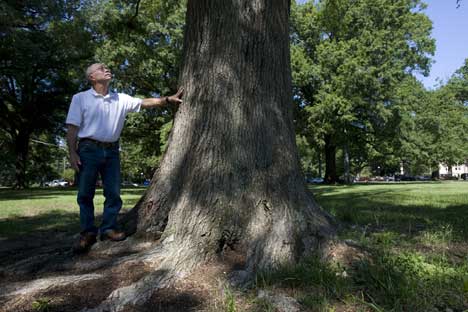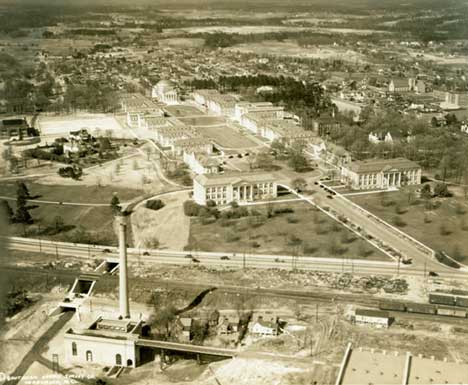Caring For East Campus' Trees
Duke plans for replacements as older trees reach their age limit

Judson Edeburn stands on the East Campus lawn surrounded by some of the campus' greatest treasures. But something is rotten. In front of him is a willow oak hollowed out by decay and disease. Behind him is a second oak with all branches but one dead. Within only 100 yards he can see as many as three trees that are near death.
Many of the great willow oaks of East Campus are almost as old as the university. Most of them were planted in the late 1920s, early 1930s after Trinity College became Duke University. Some willow oaks -- which are not a comparatively long-lived species -- are in critical condition.
"The willow oak is a very fast-growing tree," said Edeburn, manager of Duke Forest. "They were probably chosen because they grew so fast and could provide a lot of shade very quickly. The canopy of one willow oak here provides shade for more than a quarter of an acre. Some people see how big and tall they are and think they are hundreds of years old, but in fact most are not. Willow oaks generally live for 80 years or so.
"We have aerial photos from the '30s that show these trees as little saplings. They're interspersed with a number of old, mature trees. Now those trees are dead and those young trees are these mature, beautiful willow oaks. We have to make sure over the next five to 20 years that we're replacing them with new trees just as they replaced others before them."
A recent survey of East Campus trees placed all in one of four categories: dead, critical, fair and good. Most of the significant mature trees are listed in the fair category. However, since many of the trees are of the same species and were planted at the same time, there is a risk that there will be a large die-off over the next two decades. (One dying East Campus tree was cut down this week.)
That's what Duke officials are trying to avoid. While Duke grounds teams in Facilities Management are making an annual census of the trees and treating the sick ones, planners in the Office of the University Architect are creating design guidelines for tree planting on East Campus.
It's an effort of love, but also one that is important to preserving what is special about Duke. Joe Jackson, assistant director of grounds,said a recent survey of more than 500 West Campus trees -- about 10 -15 percent of the trees on campus -- put the economic value of just those specimens at about $2.6 million.
But some of what trees contribute to Duke can't just be measured by numbers, officials said. Duke's design for the new campus on Central Campus was based on the idea that Duke is a "university in a forest." And trees are such an important part of the definition of West Campus that the dying of several trees on the main quad nearly a decade ago was a source of concern.
Landscape Design for East Campus
Campus landscape planners hope to do battle with the cow paths that cross East Campus and make the freshman campus more pedestrian and bicycle friendly. As part of a design presented this spring to trustees, planners suggest changing the direction of vehicle traffic on the East Campus circle road, move the location of the bus stop and develop a pedestrian system that make it a "walkable campus."
For more, click here.
Duke Campus Landscape Architect Mark Hough says trees help define East Campus' distinctive character on campus. Rather than a "university in a forest," it's more like a "university in a park" with the trees shading open lawns, he said.
"East has a unique look," said Hough, who lives off-campus near East. "It's like an oasis in an urban grid. I've lived in the neighborhood for years, always run around it and have used it as a park. Much of its character comes from the trees."
The trees are also an important part of East Campus' link to the local community and Duke alumni. The trail that circles the campus takes visitors along a route of willow oaks, pinoaks, white oaks, pines, cherries, maples, ashes and magnolias.
"I've admired those trees since I was a freshmen," said trustee emerita Mary D.B.T. Semans. "One of the first things you think about when you arrive on East Campus is those trees. They are part of my life at Duke. It's a heartbreaker when we lose one."
Landscape design is done by the Duke architect's office in conjunction with the Grounds office with additional advice on tree issues from Edeburn. In the spring, Duke architects presented a trustee committee with a general proposal of East Campus landscape design guidelines that included a look at pedestrian walkways, vehicle traffic and a vision of future tree plantings. (See accompanying story.)
For example, Hough said one idea is to line the walkway leading to Broad Street with cherries. "There are already some great cherry trees in front of Brodie Gym and along Perry Street," Hough said. "It would be nice if you could get the whole path. This linear path to Broad Street would be come a great cherry walk. It would be very visual and symbolic."

A 1928 aerial photograph of East Campus shows some of the current trees as young saplings. Courtesy Duke University Archives
Planners are also paying attention to trees lining the walkways of the main quad on East, where some are dying out. One proposal would replace the dying trees with new ones but move them in from the residence halls and closer to the quad lawn. Hough said the move would give the trees more room to grow and improve pedestrian traffic.
Part of this effort is the planting of replacement trees. Both Hough and Edeburn said the timing and number of new plantings will depend on what money is available.
"These trees are large, and they've been here for most of our lives," Edeburn said. "To lose one is certainly significant. To get other trees into the ground to replace them is very important."